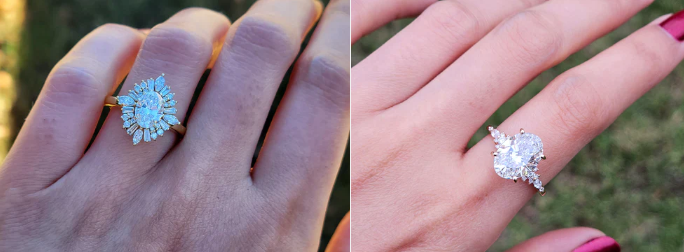When it comes to choosing the perfect engagement ring, natural diamond rings remain the most iconic and cherished option. With their unmatched brilliance, deep symbolism, and centuries of legacy, natural diamond engagement rings continue to represent everlasting love, commitment, and authenticity.
In this article, we’ll explore everything you need to know about natural diamond engagement rings — their origin, benefits, differences from lab-grown diamonds, settings, popular styles, and care tips.
🌍 What Are Natural Diamonds?
Natural diamonds are carbon crystals formed over 1 to 3 billion years deep within the Earth’s mantle under extreme pressure and temperature. They are brought closer to the surface through volcanic eruptions and later mined from kimberlite pipes or alluvial deposits.
Each natural diamond is a one-of-a-kind masterpiece created by nature — a rare and precious gem that holds both monetary and emotional value.
💎 Why Choose a Natural Diamond Engagement Ring?
1. Authenticity and Heritage
Natural diamonds carry a story of geological wonder and ancient formation, making them not just beautiful, but meaningful. They represent a deep connection to the Earth and to traditions passed down for generations.
2. Value and Rarity
Natural diamonds are finite in quantity and require extensive labor to mine and process, which adds to their rarity and long-term value. Unlike lab-grown alternatives, natural diamonds often retain or increase in value over time.
3. Timeless Beauty
With exceptional brilliance, fire, and clarity, natural diamonds continue to be the standard of excellence in the jewelry world. Their visual allure is simply unmatched.
4. Emotional Significance
Natural diamonds have adorned royal families, marked historical events, and been the centerpiece of countless love stories. Wearing a natural diamond engagement ring ties you to this rich emotional and cultural heritage.
🆚 Natural Diamonds vs. Lab-Grown Diamonds
| Feature | Natural Diamonds | Lab-Grown Diamonds |
|---|---|---|
| Origin | Earth-formed over billions of years | Created in a lab in weeks |
| Rarity | Rare and unique | Mass-produced |
| Resale Value | Typically higher | Lower resale value |
| Environmental Impact | Depends on mining practices | Less mining but energy-intensive |
| Price | More expensive | 20–40% cheaper |
While lab-grown diamonds offer an ethical and affordable option, natural diamonds hold long-term value, rarity, and emotional depth that lab-grown stones often lack.
💍 Popular Styles of Natural Diamond Engagement Rings
- Solitaire
- A single diamond mounted on a band.
- Timeless and elegant, the most classic style.
- Halo
- A central diamond surrounded by a halo of smaller diamonds.
- Adds sparkle and makes the center stone appear larger.
- Three-Stone
- Symbolizes past, present, and future.
- Often features a larger center diamond flanked by two smaller ones.
- Vintage-Inspired
- Intricate designs with milgrain, filigree, or floral motifs.
- Perfect for those who love old-world charm.
- Modern Minimalist
- Clean lines, bezel settings, or asymmetrical designs.
- Appeals to contemporary aesthetics.
📏 The 4Cs of Natural Diamonds
When selecting a diamond engagement ring, understanding the 4Cs is crucial:
- Cut – Determines how well the diamond reflects light. The most important C for sparkle.
- Color – Ranges from D (colorless) to Z (light yellow/brown).
- Clarity – Refers to internal or surface imperfections. Ranges from Flawless (FL) to Included (I).
- Carat Weight – Measures the size of the diamond.
Choosing a balanced combination of these 4Cs can help you find the best diamond within your budget.
🌿 Ethical Sourcing and Sustainability
With growing awareness, many jewelers now offer ethically sourced natural diamonds certified by organizations like the Kimberley Process, which ensures the diamonds are conflict-free.
Brands that follow sustainable mining practices and support local communities are reshaping the natural diamond industry into a more responsible one.
🧼 Caring for Your Natural Diamond Ring
To maintain the sparkle and longevity of your natural diamond engagement ring:
- Clean it regularly with mild soap and warm water.
- Use a soft brush to remove dirt and oil.
- Store it in a soft pouch or box to avoid scratches.
- Get it professionally cleaned and inspected annually.
💡 Final Thoughts
A natural diamond engagement ring is more than a piece of jewelry — it’s a lifelong symbol of love, trust, and commitment. Whether you’re drawn to its brilliance, legacy, or rarity, choosing a natural diamond means embracing something truly timeless.
As trends evolve, one thing remains constant: natural diamonds never go out of style.
✨ Are You Ready to Choose the Perfect Natural Diamond?
Look for GIA-certified diamonds, ask questions about ethical sourcing, and take your time selecting a style that speaks to your heart. After all, this ring will mark one of the most special chapters in your love story.

